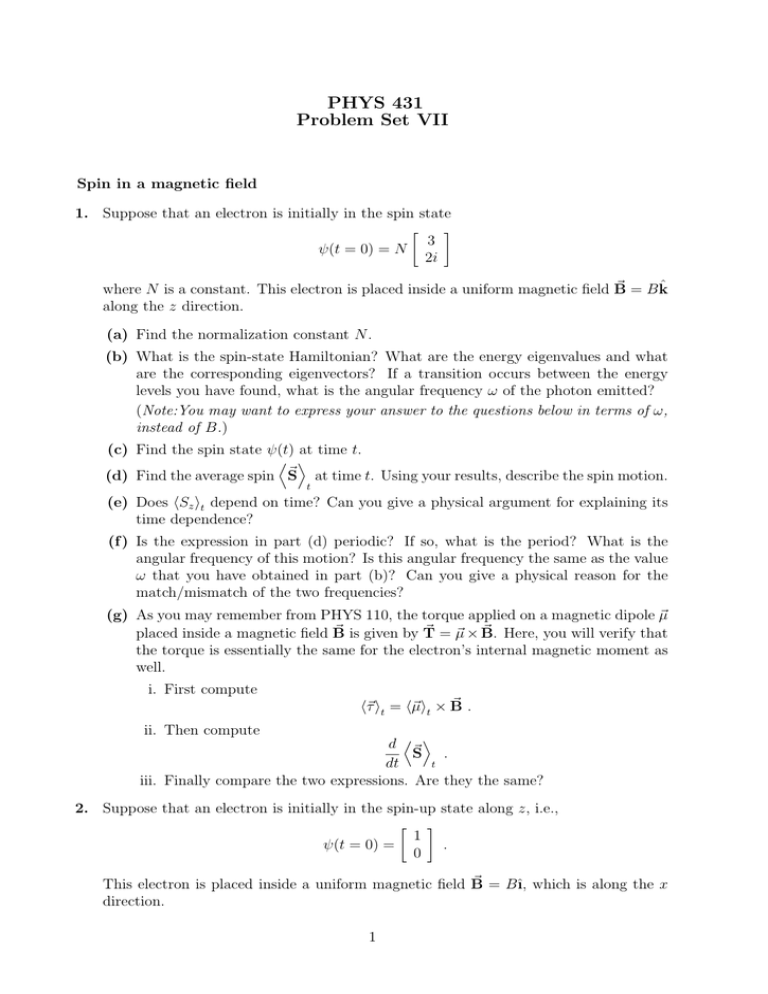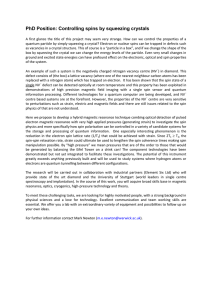PS7
advertisement

PHYS 431 Problem Set VII Spin in a magnetic field 1. Suppose that an electron is initially in the spin state [ ] 3 ψ(t = 0) = N 2i ⃗ = B k̂ where N is a constant. This electron is placed inside a uniform magnetic field B along the z direction. (a) Find the normalization constant N . (b) What is the spin-state Hamiltonian? What are the energy eigenvalues and what are the corresponding eigenvectors? If a transition occurs between the energy levels you have found, what is the angular frequency ω of the photon emitted? (Note:You may want to express your answer to the questions below in terms of ω, instead of B.) (c) Find the spin state ψ(t) at time t. ⟨ ⟩ (d) Find the average spin ⃗S at time t. Using your results, describe the spin motion. t (e) Does ⟨Sz ⟩t depend on time? Can you give a physical argument for explaining its time dependence? (f ) Is the expression in part (d) periodic? If so, what is the period? What is the angular frequency of this motion? Is this angular frequency the same as the value ω that you have obtained in part (b)? Can you give a physical reason for the match/mismatch of the two frequencies? (g) As you may remember from PHYS 110, the torque applied on a magnetic dipole ⃗µ ⃗ is given by T ⃗ = ⃗µ × B. ⃗ Here, you will verify that placed inside a magnetic field B the torque is essentially the same for the electron’s internal magnetic moment as well. i. First compute ⃗ . ⟨⃗τ ⟩t = ⟨⃗µ⟩t × B ii. Then compute d ⟨⃗ ⟩ S . dt t iii. Finally compare the two expressions. Are they the same? 2. Suppose that an electron is initially in the spin-up state along z, i.e., [ ] 1 ψ(t = 0) = . 0 ⃗ = Bı̂, which is along the x This electron is placed inside a uniform magnetic field B direction. 1 (a) What is the spin-state Hamiltonian? What are the energy eigenvalues and what are the corresponding eigenvectors? If a transition occurs between the energy levels you have found, what is the angular frequency ω of the photon emitted? (b) Find the spin state ψ(t) at time t. ⟨ ⟩ (c) Find the average spin ⃗S at time t. Using your results, describe the spin motion. t (d) Does ⟨Sx ⟩t depend on time? If H is the Hamiltonian, what is ⟨H⟩t ? Does it depend on time? (e) If Sz is measured at time t, what is the probability p↑ that the outcome will be +h̄/2? At which times t this probability becomes maximum? (f ) If Sy is measured at time t, what is the probability p↑ that the outcome will be −h̄/2? At which times t this probability becomes maximum? (g) If energy is measured at time t, (i) which results will be obtained, (ii) what is the probability of obtaining each and (iii) what is the collapsed state in each case? 3. Suppose that an electron is initially in the state [ ] 1 1 ψ(t = 0) = √ . 2 −1 ⃗ = Bȷ̂, which is along the y This electron is placed inside a uniform magnetic field B direction. (a) What is the state at time t? (b) What is ⟨⃗σ ⟩t at time t? Describe the spin motion. 4. Consider two electrons. Suppose that their spins are in the singlet state 1 |Ψ⟩ = √ (|↑↓⟩ − |↓↑⟩) 2 Let ⃗S1 and ⃗S2 denotes the spin operators for the 1st and 2nd electron respectively. (a) Suppose that you would like to measure S1z and S2z at the same time. Can you measure them at the same time? What are the common eigenstates (if any) of S1z and S2z ? (b) If you measure S1z and S2z at the same time, (i) which outcomes you would get, (ii) what is the probability of obtaining each and (iii) what is the collapsed state in each case? Complete the table below. Outcome for S1z ... Outcome for S2z ... Probability Collapsed state ... ... (c) Suppose that you want to measure S1y and S2y instead. Can you measure them at the same time? (d) The spin-up and spin-down states along y are given as |↑⟩ + i |↓⟩ |↑⟩ − i |↓⟩ √ √ , |y ↓⟩ = . 2 2 Express the singlet state |Ψ⟩ in terms of |y ↑⟩ and |y ↓⟩. After that, find the outcomes, probabilities and collapsed states for simultaneous S1y and S2y measurement? |y ↑⟩ = 2


